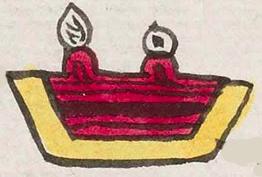Atlatlauhcan (Mdz7v)
This compound glyph for the place name Atlatlauhcan (or Atlatlauhca) is comprised of two elements, a container of water [normally, apantli, but there is no -apan- in this place name, so just atl), filled with red (tlatlauhqui) water. The container has a yellow exterior structure. The water has one white water droplet and one white turbinate shell coming off the top. It also has the wavy black lines of varying thickness (with one especially thick black line in the middle). The -can locative suffix is not shown visually in this glyph.
Stephanie Wood
This version of the place name Atlatlauhcan does have the waves of water splashing up with a shell and perhaps a droplet or precious stone (such as local jade, chalchihuitl). The one on folio 25 recto is without these added details. See below, right. The final analysis of this glyph is a challenge. The obvious reading is "Place of Red Water" (see Berdan and Anawalt), but it might also be that the color red was used because it provided the reduplication for atlauhtli (ravine or barranca, in Spanish). The result could be, just following the phonetics, "Place of Ravines." If this is Atlatlauhcan, Morelos, there are at least three ravines around it, according to the geography description in Wikipedia. If the name is about ravines, then this is another example where we should not take a glyph literally. Frances Karttunen suggests: "Where There Are Barrancas Here and There," with the "here and there" deriving from the reduplication of the beginning of the word for ravine (atlauhtli). She adds that she is assuming the reduplication would be ātlahtlauh- rather than ahātlauh-.
Stephanie Wood
atlatlauhca. puo
Atlatlauhcan, pueblo
Stephanie Wood
c. 1541, or by 1553 at the latest
Stephanie Wood
red, waters, shells, rojo, aguas, caracoles, canals, canales, nombres de lugares

a(tl) or ā(tl), water, https://nahuatl.wired-humanities.org/content/atl
tlatlauh(qui), red, https://nahuatl.wired-humanities.org/content/tlatlauhqui
atlauh(tli) or ātlauh(tli), , ravine (barranca in Spanish), https://nahuatl.wired-humanities.org/content/atlauhtli
-can or -cān; (locative suffix), https://nahuatl.wired-humanities.org/content/can-2
"Where There Are Barrancas Here and There" [Frances Karttunen, unpublished manuscript.]
"Place of Red Water" (Berdan and Anawalt, 1992, vol. 1, p. 173)
"Donde Hay Varias Barrancas"
Stephanie Wood
Codex Mendoza, folio 7 verso, https://digital.bodleian.ox.ac.uk/objects/2fea788e-2aa2-4f08-b6d9-648c00..., image 25, of 188.
The Bodleian Libraries, University of Oxford, hold the original manuscript, the MS. Arch. Selden. A. 1. This image is published here under the UK Creative Commons, “Attribution-NonCommercial-ShareAlike 3.0 License” (CC-BY-NC-SA 3.0).

